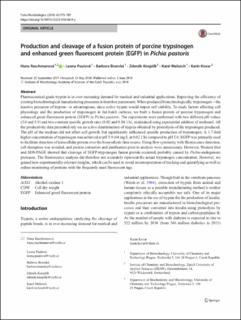Please use this identifier to cite or link to this item:
https://doi.org/10.21256/zhaw-25703Full metadata record
| DC Field | Value | Language |
|---|---|---|
| dc.contributor.author | Raschmanová, Hana | - |
| dc.contributor.author | Paulová, Leona | - |
| dc.contributor.author | Branská, Barbora | - |
| dc.contributor.author | Knejzlík, Zdeněk | - |
| dc.contributor.author | Melzoch, Karel | - |
| dc.contributor.author | Kovar, Karin | - |
| dc.date.accessioned | 2022-09-30T09:30:35Z | - |
| dc.date.available | 2022-09-30T09:30:35Z | - |
| dc.date.issued | 2018-11 | - |
| dc.identifier.issn | 0015-5632 | de_CH |
| dc.identifier.issn | 1874-9356 | de_CH |
| dc.identifier.uri | https://digitalcollection.zhaw.ch/handle/11475/25703 | - |
| dc.description | Erworben im Rahmen der Schweizer Nationallizenzen (http://www.nationallizenzen.ch) | de_CH |
| dc.description.abstract | Pharmaceutical grade trypsin is in ever-increasing demand for medical and industrial applications. Improving the efficiency of existing biotechnological manufacturing processes is therefore paramount. When produced biotechnologically, trypsinogen-the inactive precursor of trypsin-is advantageous, since active trypsin would impair cell viability. To study factors affecting cell physiology and the production of trypsinogen in fed-batch cultures, we built a fusion protein of porcine trypsinogen and enhanced green fluorescent protein (EGFP) in Pichia pastoris. The experiments were performed with two different pH values (5.0 and 5.9) and two constant specific growth rates (0.02 and 0.04 1/h), maintained using exponential addition of methanol. All the productivity data presented rely on an active determination of trypsin obtained by proteolysis of the trypsinogen produced. The pH of the medium did not affect cell growth, but significantly influenced specific production of trypsinogen: A 1.7-fold higher concentration of trypsinogen was achieved at pH 5.9 (64 mg/L at 0.02 1/h) compared to pH 5.0. EGFP was primarily used to facilitate detection of intracellular protein over the biosynthetic time course. Using flow cytometry with fluorescence detection, cell disruption was avoided, and protein extraction and purification prior to analysis were unnecessary. However, Western blot and SDS-PAGE showed that cleavage of EGFP-trypsinogen fusion protein occurred, probably caused by Pichia-endogenous proteases. The fluorescence analysis did therefore not accurately represent the actual trypsinogen concentration. However, we gained new experimentally-relevant insights, which can be used to avoid misinterpretation of tracking and quantifying as well as online-monitoring of proteins with the frequently used fluorescent tags. | de_CH |
| dc.language.iso | en | de_CH |
| dc.publisher | Springer | de_CH |
| dc.relation.ispartof | Folia Microbiologica | de_CH |
| dc.rights | Licence according to publishing contract | de_CH |
| dc.subject | Animal | de_CH |
| dc.subject | Culture media | de_CH |
| dc.subject | Gene expression | de_CH |
| dc.subject | Green fluorescent protein | de_CH |
| dc.subject | Hydrogen-ion concentration | de_CH |
| dc.subject | Pichia | de_CH |
| dc.subject | Protein processing, post-translational | de_CH |
| dc.subject | Recombinant fusion protein | de_CH |
| dc.subject | Swine | de_CH |
| dc.subject | Trypsinogen | de_CH |
| dc.subject.ddc | 660.6: Biotechnologie | de_CH |
| dc.title | Production and cleavage of a fusion protein of porcine trypsinogen and enhanced green fluorescent protein (EGFP) in Pichia pastoris | de_CH |
| dc.type | Beitrag in wissenschaftlicher Zeitschrift | de_CH |
| dcterms.type | Text | de_CH |
| zhaw.departement | Life Sciences und Facility Management | de_CH |
| zhaw.organisationalunit | Institut für Chemie und Biotechnologie (ICBT) | de_CH |
| dc.identifier.doi | 10.1007/s12223-018-0619-y | de_CH |
| dc.identifier.doi | 10.21256/zhaw-25703 | - |
| dc.identifier.pmid | 29872953 | de_CH |
| zhaw.funding.eu | No | de_CH |
| zhaw.issue | 6 | de_CH |
| zhaw.originated.zhaw | Yes | de_CH |
| zhaw.pages.end | 787 | de_CH |
| zhaw.pages.start | 773 | de_CH |
| zhaw.publication.status | publishedVersion | de_CH |
| zhaw.volume | 63 | de_CH |
| zhaw.publication.review | Peer review (Publikation) | de_CH |
| zhaw.author.additional | No | de_CH |
| zhaw.display.portrait | Yes | de_CH |
| Appears in collections: | Publikationen Life Sciences und Facility Management | |
Files in This Item:
| File | Description | Size | Format | |
|---|---|---|---|---|
| 2018_Raschmanova-etal_Fusion-protein-of-porcine-trypsinogen-and-EGFP-Pichia-pastoris.pdf | 1.19 MB | Adobe PDF |  View/Open |
Show simple item record
Raschmanová, H., Paulová, L., Branská, B., Knejzlík, Z., Melzoch, K., & Kovar, K. (2018). Production and cleavage of a fusion protein of porcine trypsinogen and enhanced green fluorescent protein (EGFP) in Pichia pastoris. Folia Microbiologica, 63(6), 773–787. https://doi.org/10.1007/s12223-018-0619-y
Raschmanová, H. et al. (2018) ‘Production and cleavage of a fusion protein of porcine trypsinogen and enhanced green fluorescent protein (EGFP) in Pichia pastoris’, Folia Microbiologica, 63(6), pp. 773–787. Available at: https://doi.org/10.1007/s12223-018-0619-y.
H. Raschmanová, L. Paulová, B. Branská, Z. Knejzlík, K. Melzoch, and K. Kovar, “Production and cleavage of a fusion protein of porcine trypsinogen and enhanced green fluorescent protein (EGFP) in Pichia pastoris,” Folia Microbiologica, vol. 63, no. 6, pp. 773–787, Nov. 2018, doi: 10.1007/s12223-018-0619-y.
RASCHMANOVÁ, Hana, Leona PAULOVÁ, Barbora BRANSKÁ, Zdeněk KNEJZLÍK, Karel MELZOCH und Karin KOVAR, 2018. Production and cleavage of a fusion protein of porcine trypsinogen and enhanced green fluorescent protein (EGFP) in Pichia pastoris. Folia Microbiologica. November 2018. Bd. 63, Nr. 6, S. 773–787. DOI 10.1007/s12223-018-0619-y
Raschmanová, Hana, Leona Paulová, Barbora Branská, Zdeněk Knejzlík, Karel Melzoch, and Karin Kovar. 2018. “Production and Cleavage of a Fusion Protein of Porcine Trypsinogen and Enhanced Green Fluorescent Protein (EGFP) in Pichia Pastoris.” Folia Microbiologica 63 (6): 773–87. https://doi.org/10.1007/s12223-018-0619-y.
Raschmanová, Hana, et al. “Production and Cleavage of a Fusion Protein of Porcine Trypsinogen and Enhanced Green Fluorescent Protein (EGFP) in Pichia Pastoris.” Folia Microbiologica, vol. 63, no. 6, Nov. 2018, pp. 773–87, https://doi.org/10.1007/s12223-018-0619-y.
Items in DSpace are protected by copyright, with all rights reserved, unless otherwise indicated.